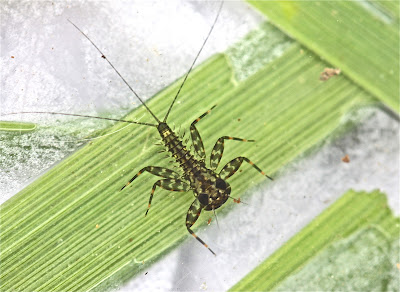Friday, May 4, 2012
A Shocker and a Mystery at Buck Mt. Creek
And I do mean a "shocker"! The flatheaded mayfly Heptagenia marginalis. This is a insect I expect to see in the summer -- July and August -- not in May. I saw the first one last year on July 25! True, everything's showing up early this year because of the mild conditions we've had in the winter and spring -- but this one took me by surprise.
When I first saw it I thought it must be a genus Leucrocuta -- but the head is too small (see the entry for Tuesday). And, the yellow on tergite 8 is characteristic of Heptagenia nymphs. But I wasn't sure about the ID until I downloaded the pictures. Remember that there is fibrilliform (small, feathery filaments) behind the gill on tergite 7 on Heptagenia nymphs: that fibrilliform is missing on Leucrocuta. Look closely at the final gill on this nymph in the photo below and you can actually see the fibrilliform there -- a small dark thread. (Click on the photo to enlarge it.)
If that doesn't work, here is a microscope view.
This is one of my favorite flatheaded mayflies, and it's nice to see them early this year. Later, they'll look something like this.
As for the mystery... I was hoping to see some small minnow mayflies today: our summer species (B. pluto, A. nadineae, B. intercalaris, and H. curiosum) should show up anytime now. And I did find two small minnow mayflies -- but I'm not sure what they are! They were very small (3-4 mm) and different colors (male and female?), and at first I thought they were Plauditus dubius nymphs. But the abdominal colors don't match that at all. And they are not genus Heterocloeon -- no forecoxal gills. Acentrella turbida? Possibly. But I need to do more microscope work to see if I can figure this out. In any event, here are some photos -- not the best since the nymphs were so small, and the light conditions today were less than ideal.
(Note added 5/5/12: They were indeed Acentrella turbida.)
____________
The other insects I saw were not unexpected. I saw lots of Epeorus vitreus flatheaded mayflies, which are getting fairly mature, and I again ran into a number of the large spiny crawlers Drunella tuberculata.
What I did not see were the hordes of the common spiny crawler -- E. dorothea -- that I've been running into of late. But, May is hatch time for that species, and I think the nymphs are disappearing now from our streams.
Subscribe to:
Post Comments (Atom)









No comments:
Post a Comment